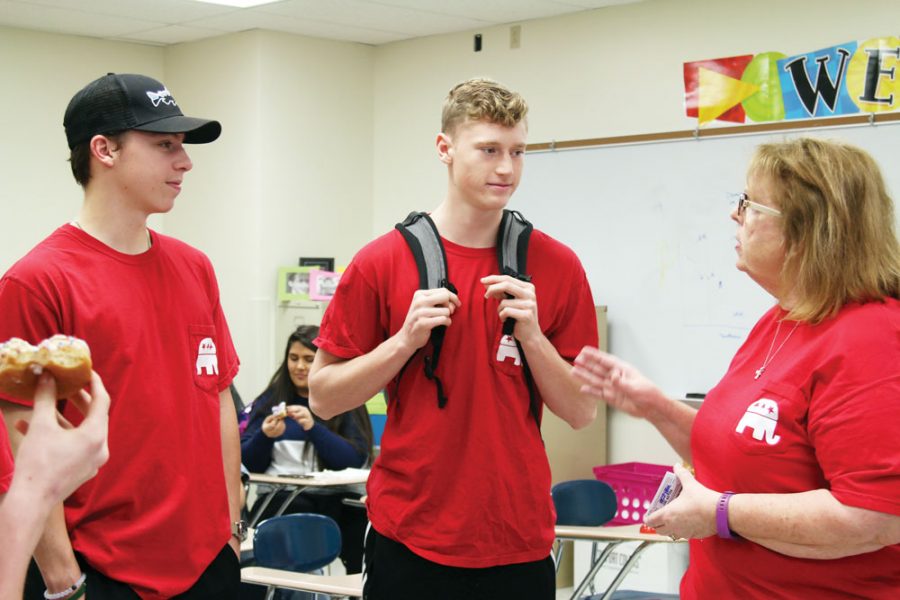[dropcap style=”flat”]T[/dropcap]he inauguration of president Donald Trump was livestreamed in the media center Jan. 20. Beth Shapiro, RBHS media specialist, showed a fact-checking website next to the video, an act that Shapiro said was agreed upon by other media specialists in Columbia Public Schools (CPS).
Shapiro said she was surprised when, after the speech had ended, RBHS principal Dr. Jennifer Rukstad spoke with her, saying the school board had “heard about” what she had done and “was not happy with it.”
Dr. Rukstad said that someone informed the school board that Shapiro showed a fact-checking website adjacent to the inauguration and made the decision to have the fact-checking website taken down. A choice that, in her opinion, was made as a result of the context of today’s boisterous political climate — a sentiment expressed by citizens and politicians alike.
“The issue of bias in the media and fake news and this phenomenon of constantly questioning the media and their sources has never been bigger — not in any recent history — than this election cycle,” Dr. Rukstad said. “It is the dividing line for many people. The candidates, the election, the way it went, the way it was influenced or not, all of those things, it’s a completely unique situation.”
CPS superintendent Dr. Peter Stiepleman explained that the district had planned for the inauguration for months, and Dr. Rukstad was following instructions.
The campaigns of Hillary Clinton and Donald Trump divided the country, creating rivalry and contention among citizens. With the recent election of Trump, those sentiments have increased, sparking bias and disagreement around the country, even in the halls of RBHS.
As a result, students and teachers become consumers of rhetoric from politicians and news organizations. As a result, Dr. Stiepleman explained, a “Cabinet’s directive” ordered schools to display C-SPAN’s coverage because it was the only program that did not offer additional commentary. In response, faculty members, including Shapiro, have tried to assist students in identifying today’s biased news.
“It was not my intention to make any kind of political statement, this was simply an exercise in information literacy,” Shapiro said. “My job as a media specialist is to help people find reliable sources. I would have done the same thing if another candidate had won. It’s to get people to think critically about information.”
Dr. Rukstad believes the media specialists did not intentionally express bias but the polarizing nature of the election made additional gestures like the fact checking website a display of commentary on behalf of the school.
While she appreciates the assistance offered by the specialists, she said the volatility of today’s culture makes it difficult for anything to be unbiased.
The decision to show a fact-checking website was a part of a year-long effort to help students find reliable sources and research objectively. Faculty members, such as civics teacher Kelley Wittenborn, are strongly supportive of Shapiro’s efforts.
“That’s been Shapiro’s platform all year,” Wittenborn said. “She’s been helping students find websites that were trustworthy and how to figure out if a news story was real or fake.”
As a result of the bias in media, AP World History teacher Shawnna Matteson said critical thinking and thorough research are necessary. Matteson said people need to fight the natural tendency to read and support uncontextualized, impassioned rhetoric that agrees with preexisting opinions.
“As an educator I think it’s important to be informed,” Matteson said. “There’s so much misinformation out there that if you can’t think critically, you’re just going to follow the whims of whoever is talking the loudest.”
Concepts of fairness and objectivity are not foreign ones but individuals, as they get more exposed to the world, often lose sense of these ideals, Matteson said.
Junior Max Simmons believes unbiased news and neutral classroom settings are vital to learning, especially for students. The New York Times has a learning index available to teachers with unbiased lesson plans; it’s resources like these Simmons wishes teachers would use more.
“Unbiased news is a very large problem,” Simmons said. “Many people get most of their news from social media . . . and with many people who don’t know the difference between fair and biased media, an opinion is formed in their head without them realizing it because they don’t get the full story.”
Shapiro recognizes the necessity of pursuing unbiased, factual news, encouraging and supporting students to seek the truth.
In her how-to-find-objective-news presentations to social studies classes, Shapiro shared with students a statistic from Stanford that found 80-90 percent of students can’t differentiate from fake or real news.
“It’s enormously important [to think critically in the internet age] because we have just an infinite amount of information,” Shapiro said. “You do have to be a critical thinker in order to find sources you can rely on. You have to look at whether something is current or relevant. You have to look at various sources so that you’re not just getting information from one source.”
by Ji-Ho Lee and Kat Sarafianos













































































